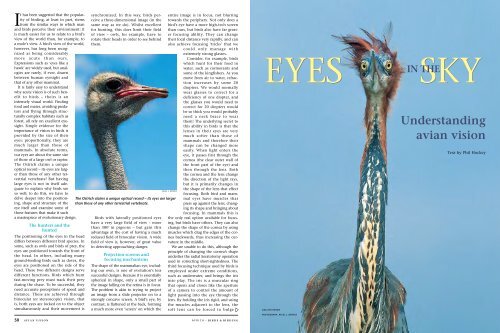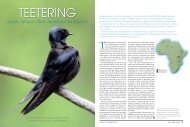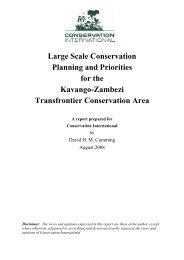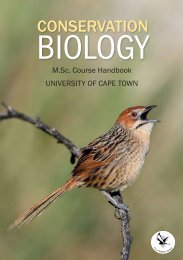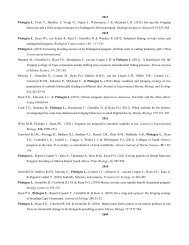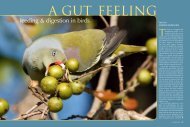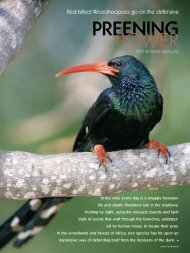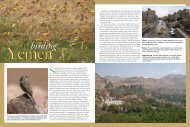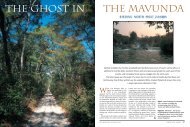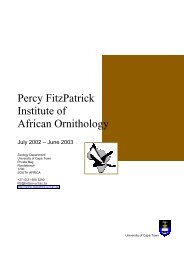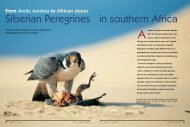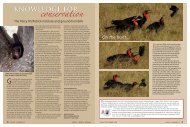Eyes in the sky: understanding avian vision
Eyes in the sky: understanding avian vision
Eyes in the sky: understanding avian vision
You also want an ePaper? Increase the reach of your titles
YUMPU automatically turns print PDFs into web optimized ePapers that Google loves.
It has been suggested that <strong>the</strong> popularityof bird<strong>in</strong>g, at least <strong>in</strong> part, stemsfrom <strong>the</strong> similar ways <strong>in</strong> which manand birds perceive <strong>the</strong>ir environment: itis much easier for us to relate to a bird’sview of <strong>the</strong> world than, for example, toa mole’s view. A bird’s view of <strong>the</strong> world,however, has long been recognizedas be<strong>in</strong>g considerablymore acute than ours.Expressions such as ‘eyes like ahawk’ are widely used, but analogiesare rarely, if ever, drawnbetween human eyesight andthat of any o<strong>the</strong>r mammal.It is fairly easy to understandwhy acute <strong>vision</strong> is of such benefitto birds – <strong>the</strong>irs is an<strong>in</strong>tensely visual world. F<strong>in</strong>d<strong>in</strong>gfood and mates, avoid<strong>in</strong>g predatorsand fly<strong>in</strong>g through structurallycomplex habitats such asforest, all rely on excellent eyesight.Simple evidence for <strong>the</strong>importance of <strong>vision</strong> <strong>in</strong> birds isprovided by <strong>the</strong> size of <strong>the</strong>ireyes: proportionally, <strong>the</strong>y aremuch larger than those ofmammals. In absolute terms,our eyes are about <strong>the</strong> same sizeof those of a large owl or raptor.The Ostrich claims a uniqueoptical record – its eyes are largerthan those of any o<strong>the</strong>r terrestrialvertebrate! But hav<strong>in</strong>glarge eyes is not <strong>in</strong> itself adequateto expla<strong>in</strong> why birds seeso well; to do this, we have todelve deeper <strong>in</strong>to <strong>the</strong> position<strong>in</strong>g,shape and structure of <strong>the</strong>eye itself and exam<strong>in</strong>e some ofthose features that make it sucha masterpiece of evolutionary design.The hunters and <strong>the</strong>huntedThe position<strong>in</strong>g of <strong>the</strong> eyes <strong>in</strong> <strong>the</strong> headdiffers between different bird species. Insome, such as owls and birds of prey, <strong>the</strong>eyes are positioned towards <strong>the</strong> front of<strong>the</strong> head. In o<strong>the</strong>rs, <strong>in</strong>clud<strong>in</strong>g manyground-feed<strong>in</strong>g birds such as doves, <strong>the</strong>eyes are positioned on <strong>the</strong> side of <strong>the</strong>head. These two different designs servedifferent functions. Birds which huntfast-mov<strong>in</strong>g prey must track <strong>the</strong>ir preydur<strong>in</strong>g <strong>the</strong> chase. To be successful, <strong>the</strong>yneed accurate perceptions of speed anddistance. These are achieved throughb<strong>in</strong>ocular (or stereoscopic) <strong>vision</strong>, thatis, both eyes are locked on to <strong>the</strong> objectsimultaneously and <strong>the</strong>ir movement issynchronized. In this way, birds perceivea three-dimensional image (<strong>in</strong> <strong>the</strong>same way as we do). Whilst excellentfor hunt<strong>in</strong>g, this does limit <strong>the</strong>ir fieldof view – owls, for example, have torotate <strong>the</strong>ir heads <strong>in</strong> order to see beh<strong>in</strong>d<strong>the</strong>m.The Ostrich claims a unique optical record – its eyes are largerthan those of any o<strong>the</strong>r terrestrial vertebrate.Birds with laterally positioned eyeshave a very large field of view – morethan 300 ° <strong>in</strong> pigeons – but ga<strong>in</strong> thisadvantage at <strong>the</strong> cost of hav<strong>in</strong>g a muchreduced field of b<strong>in</strong>ocular <strong>vision</strong>. A widefield of view is, however, of great value<strong>in</strong> detect<strong>in</strong>g approach<strong>in</strong>g danger.Projection screens andfocus<strong>in</strong>g mechanismsThe shape of <strong>the</strong> mammalian eye, <strong>in</strong>clud<strong>in</strong>gour own, is one of evolution’s lesssuccessful designs. Because it is essentiallyspherical <strong>in</strong> shape, only a small part of<strong>the</strong> image fall<strong>in</strong>g on <strong>the</strong> ret<strong>in</strong>a is <strong>in</strong> focus.The problem is ak<strong>in</strong> to try<strong>in</strong>g to projectan image from a slide projector on to astrongly concave screen. A bird’s eye, bycontrast, is flattened at <strong>the</strong> back, form<strong>in</strong>ga much more even ‘screen’ on which <strong>the</strong>entire image is <strong>in</strong> focus, not blurr<strong>in</strong>gtowards <strong>the</strong> periphery. Not only does abird’s eye have a more high-tech screenthan ours, but birds also have far greaterfocus<strong>in</strong>g ability. They can change<strong>the</strong>ir focal distance very rapidly, and canalso achieve focus<strong>in</strong>g ‘tricks’ that wecould only manage wi<strong>the</strong>xtremely strong glasses.Consider, for example, birdswhich hunt for <strong>the</strong>ir food <strong>in</strong>water, such as cormorants andsome of <strong>the</strong> k<strong>in</strong>gfishers. As youmove from air to water, refraction<strong>in</strong>creases by some 20diopters. We would normallywear glasses to correct for adeficiency of one diopter, and<strong>the</strong> glasses you would need tocorrect for 20 diopters wouldbe so thick you would probablyneed a neck brace to wear<strong>the</strong>m! The underly<strong>in</strong>g secret tothis ability <strong>in</strong> birds is that <strong>the</strong>lenses <strong>in</strong> <strong>the</strong>ir eyes are verymuch softer than those ofmammals and <strong>the</strong>refore <strong>the</strong>irshape can be changed moreeasily. When light enters <strong>the</strong>eye, it passes first through <strong>the</strong>cornea (<strong>the</strong> clear outer wall of<strong>the</strong> front part of <strong>the</strong> eye) and<strong>the</strong>n through <strong>the</strong> lens. Both<strong>the</strong> cornea and <strong>the</strong> lens change<strong>the</strong> direction of <strong>the</strong> light rays,but it is primarily changes <strong>in</strong><strong>the</strong> shape of <strong>the</strong> lens that effectfocus<strong>in</strong>g. Both bird and mammaleyes have muscles thatpress up aga<strong>in</strong>st <strong>the</strong> lens, chang<strong>in</strong>gits shape and br<strong>in</strong>g<strong>in</strong>g aboutfocus<strong>in</strong>g. In mammals this is<strong>the</strong> only real option available for focus<strong>in</strong>g,but birds have o<strong>the</strong>rs. They can alsochange <strong>the</strong> shape of <strong>the</strong> cornea by us<strong>in</strong>gmuscles which drag <strong>the</strong> edges of <strong>the</strong> corneabackwards, thus <strong>in</strong>creas<strong>in</strong>g <strong>the</strong> curvature<strong>in</strong> <strong>the</strong> middle.We are unable to do this, although <strong>the</strong>pr<strong>in</strong>ciple of chang<strong>in</strong>g <strong>the</strong> cornea’s shapeunderlies <strong>the</strong> radial keratotomy operationused <strong>in</strong> correct<strong>in</strong>g short-sightedness. Thethird focus<strong>in</strong>g technique used by birds isemployed under extreme conditions,such as underwater, and br<strong>in</strong>gs <strong>the</strong> iris<strong>in</strong>to play. The iris is a muscular r<strong>in</strong>gthat opens and closes like <strong>the</strong> apertureof a camera to control <strong>the</strong> amount oflight pass<strong>in</strong>g <strong>in</strong>to <strong>the</strong> eye through <strong>the</strong>lens. By hold<strong>in</strong>g <strong>the</strong> iris rigid, and us<strong>in</strong>g<strong>the</strong> muscles adjacent to <strong>the</strong> lens, <strong>the</strong>soft lens can be forced to bulge NIGEL J. DENNIS50 AVIAN VISIONafrica – birds & bird<strong>in</strong>gEYESGOLIATH HERONPHOTOGRAPH: NIGEL J. DENNISSKYIN THESKYUnderstand<strong>in</strong>g<strong>avian</strong> <strong>vision</strong>Text by Phil Hockey
Over evolutionarytime, <strong>the</strong> <strong>avian</strong> eye hasdeveloped a plethoraof special and uniquefeatures which make itone of Nature’s f<strong>in</strong>estdesigns.PETER STEYNNIGEL J. DENNISthrough <strong>the</strong> open<strong>in</strong>g of <strong>the</strong> iris, achiev<strong>in</strong>gextreme curvature. The more rigidlens of a mammal precludes this focus<strong>in</strong>goption.Receiv<strong>in</strong>g <strong>the</strong> signalWhen light enters <strong>the</strong> eye and falls on<strong>the</strong> ret<strong>in</strong>a, an image is perceived anddecoded by <strong>the</strong> bra<strong>in</strong>. The ret<strong>in</strong>a thusacts as an <strong>in</strong>terface between <strong>the</strong> outsideworld and <strong>the</strong> biological computer, <strong>the</strong>bra<strong>in</strong>. Light falls on to, and triggers,nerve cells <strong>in</strong> <strong>the</strong> ret<strong>in</strong>a. The signal ispassed from <strong>the</strong> ret<strong>in</strong>a along a nervecha<strong>in</strong>. There are two types of light- orphoto-sensitive cells <strong>in</strong> <strong>the</strong> ret<strong>in</strong>a – rodsAbove The large, frontally positionedeyes of owls provide <strong>the</strong>m with excellentstereoscopic <strong>vision</strong>. Because <strong>the</strong>se birdshunt primarily <strong>in</strong> low light conditions, <strong>the</strong>irret<strong>in</strong>as are rich <strong>in</strong> rods. The Spotted EagleOwl shown here is a typical example.Below <strong>Eyes</strong> positioned on <strong>the</strong> side of <strong>the</strong>head, as <strong>in</strong> this Namaqua Dove, donot work well for stereoscopic <strong>vision</strong> butcan detect <strong>the</strong> approach of dangerfrom almost any quarter.PETER STEYNand cones. These differ <strong>in</strong> <strong>the</strong> circuitrythrough which <strong>the</strong>y pass messages to<strong>the</strong> bra<strong>in</strong>. In <strong>the</strong> case of rods, severalconverge on a s<strong>in</strong>gle nerve cha<strong>in</strong> to <strong>the</strong>bra<strong>in</strong>. This design <strong>in</strong>creases <strong>the</strong> strengthof <strong>the</strong> signal through a multiplier effect.Cones, by contrast, each have <strong>the</strong>ir owndedicated l<strong>in</strong>e to <strong>the</strong> bra<strong>in</strong>. Because <strong>the</strong>strength of <strong>in</strong>com<strong>in</strong>g light determ<strong>in</strong>es<strong>the</strong> strength of signals sent to <strong>the</strong> bra<strong>in</strong>(which is why your eyes hurt <strong>in</strong> brightlight), cones are most effective undergood light conditions – send<strong>in</strong>g very clearimages to <strong>the</strong> bra<strong>in</strong> – and rods work bestunder low light conditions – amplify<strong>in</strong>g<strong>the</strong> signal but los<strong>in</strong>g some of <strong>the</strong> def<strong>in</strong>ition.Nocturnal birds have ret<strong>in</strong>as rich<strong>in</strong> rods, and diurnal birds have ret<strong>in</strong>asrich <strong>in</strong> cones.High-quality reception...and magnify<strong>in</strong>g glassesMammals also have rods and cones <strong>in</strong><strong>the</strong> ret<strong>in</strong>a, so <strong>the</strong>se alone are not a reasonfor birds’ excellent eyesight. Theirgreater efficiency <strong>in</strong> birds can only beunderstood <strong>in</strong> conjunction with <strong>the</strong> way<strong>in</strong> which <strong>the</strong> eye receives nutrition(without which it could not function).The mammalian ret<strong>in</strong>a is richly suppliedwith blood vessels. These take up spaceand <strong>the</strong>refore compromise <strong>the</strong> numberof rods and cones that can be accommodated<strong>in</strong> <strong>the</strong> ret<strong>in</strong>a. There is no bloodsupply to <strong>the</strong> <strong>avian</strong> ret<strong>in</strong>a, so that it canbe dedicated entirely to receiv<strong>in</strong>g andpass<strong>in</strong>g on light signals. Nutrition isprovided to <strong>the</strong> bird’s eye by way of asmall, blood-rich structure called <strong>the</strong> pecten. So as not to disrupt picturereception, <strong>the</strong> pecten is anchored to asmall area of <strong>the</strong> ret<strong>in</strong>a called <strong>the</strong> opticdisc: this is where <strong>the</strong> nerves from <strong>the</strong>photo-sensitive cells come toge<strong>the</strong>r andleave <strong>the</strong> eye en route to <strong>the</strong> bra<strong>in</strong>. Thereare no rods or cones at <strong>the</strong> po<strong>in</strong>t wherethis nerve cable leaves <strong>the</strong> eye, so <strong>vision</strong>is not impaired. In both birds and mammals,<strong>the</strong>re is a small area <strong>in</strong> <strong>the</strong> middleof <strong>the</strong> ret<strong>in</strong>a that is thicker than <strong>the</strong> rest.This is a region particularly rich <strong>in</strong> conesand is unimag<strong>in</strong>atively termed <strong>the</strong> ‘centralarea’.In birds, <strong>the</strong> central area may have adepression with<strong>in</strong> it (called a fovea).This acts as a small magnify<strong>in</strong>g glass,and projects a slightly enlarged imageon to <strong>the</strong> ret<strong>in</strong>a. Some birds which pursueprey at high speed have two foveas<strong>in</strong> each eye – <strong>the</strong>se are thought to help<strong>in</strong> stereoscopic <strong>vision</strong>.Colour <strong>vision</strong> and beyondMany birds are brightly coloured and frequentlyuse <strong>the</strong>se colours <strong>in</strong> social ando<strong>the</strong>r displays. This <strong>in</strong> itself is good evidencethat <strong>the</strong>y have colour <strong>vision</strong>. Thecolour image is provided by visual pigments<strong>in</strong> <strong>the</strong> cones. In addition to <strong>the</strong>se,however, birds also have brightly colouredoil droplets <strong>in</strong>corporated <strong>in</strong> <strong>the</strong>ir cones. Itis thought that <strong>the</strong>se work not <strong>in</strong> produc<strong>in</strong>ga colour image per se, but by act<strong>in</strong>g asfilters to enhance contrast <strong>in</strong> <strong>the</strong> sameway as photographic filters do. Thus, yellowdroplets would remove much of <strong>the</strong>blue from <strong>the</strong> background, enhanc<strong>in</strong>gcontrast between an object and a blueAbove Birds which hunt <strong>the</strong>ir preyunder water, such as this Pied K<strong>in</strong>gfisher,must be able to cope with 20 dioptersof refraction – much more than <strong>the</strong> humaneye can handle.Below A Lesser Double-collaredSunbird feeds at an erica. Birds canprobably sense ultraviolet light and mayuse this ability <strong>in</strong> <strong>the</strong> same way asnectar-feed<strong>in</strong>g <strong>in</strong>sects to detect ultraviolet‘nectar-guides’ on flowers.PETER STEYN<strong>sky</strong>. Red droplets would remove much of<strong>the</strong> green, which would help birds search<strong>in</strong>gfor <strong>in</strong>sects <strong>in</strong> a forest.Unlike us, birds are sensitive to ultravioletlight. They also seem to be able todetect polarized light, and this abilitymay be particularly important <strong>in</strong> navigation.The pattern of light polarization <strong>in</strong><strong>the</strong> <strong>sky</strong> changes dur<strong>in</strong>g <strong>the</strong> day as <strong>the</strong>sun’s position moves. This may wellhelp migrat<strong>in</strong>g birds which use <strong>the</strong> sun’sposition as a compass – especially onovercast days.At <strong>the</strong> beg<strong>in</strong>n<strong>in</strong>g of this article, I statedthat birds were highly visual animals.Over evolutionary time, <strong>the</strong> <strong>avian</strong> eyehas developed a plethora of special andunique features which make it one ofNature’s f<strong>in</strong>est designs. Perhaps we arecorrect <strong>in</strong> draw<strong>in</strong>g <strong>the</strong> analogy between<strong>the</strong> way <strong>in</strong> which man and birds perceive<strong>the</strong> environment, <strong>the</strong> differencebe<strong>in</strong>g that birds see it with a clarity wecould only dream of!Many birds are brightlycoloured and frequentlyuse <strong>the</strong>se colours <strong>in</strong>social and o<strong>the</strong>rdisplays. This <strong>in</strong> itself isgood evidence that <strong>the</strong>yhave colour <strong>vision</strong>.52 AVIAN VISIONafrica – birds & bird<strong>in</strong>g1997 – volume 2, number 6AVIAN VISION53


